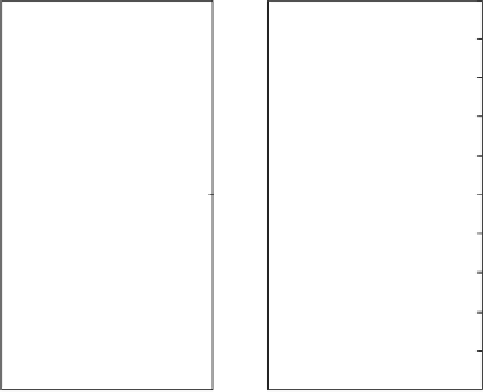Biomedical Engineering Reference
In-Depth Information
Load on PC 1
Load on PC 2
10
10
9
9
8
8
7
7
6
6
5
5
4
4
3
3
2
2
1
1
250
300
350
250
300
350
Wavelength (nm)
Wavelength (nm)
Figure
11.4.
Principal component loadings that correspond to PC 1 and PC 2 in Fig. 11.3. PC 2 has
an intensity pattern that suggests media additive Lot 1 (from Fig. 11.3) has more material
absorbing at wavelengths greater than 300 nm and less material from 7.5 to 8.5min. (Blue: less
intense; red: more intense.) Not many differences are observed in the PC 1 loadings that reflect
the sample scores plot. (See the insert for color representation of this figure.)
chromatograms. The pattern for PC 2 where Lot 1 is distinct from the other lots may be
significant because the use test indicated Lot 1 was the only lot that performed well for
cell culture. Next, the underlying signals that account for the distinction of Lot 1 will be
examined.
Figure 11.4 shows the loadings for the first two principal components. The loadings
reveal what spectral and chromatographic characteristics are responsible for the sample
scores shown in Fig. 11.3. Because only PC 2 followed the pattern of interest to cell
culture, most attention will focus on understanding the loading for PC 2. The images in
Fig. 11.4 show color contours distributed by retention time and wavelength. Lot 1 has
more intense signals (more red color in the image) at wavelengths above 300 nmbetween
2 and 7.5 min. UV-Vis absorbance spectrum of these lots confirms that Lot 1 has more
relative absorbance in this wavelength region than the other lots (data not shown). The PC
2 loadings in Fig. 11.4 also reveal that Lot 1 has less material eluting from 7.5 to 8.5 min
that absorbs 300-350 nm. Again, it is easy to confirm this observation by overlaying
chromatograms in the 300-350 nm wavelength range (Fig. 11.5). Lot 1 has less material
eluting between 7.5 and 8.5 min.
The benefit of MVA analysis applied to compare these chromatographic profiles is
obvious from this small example. Without this MVA map, about 50 chromatograms
would need to be compared, 12 chromatograms at approximately 5 wavelengths—too
many to plot on one page. UsingMVA, entire data cubes can be compared and interpreted
























